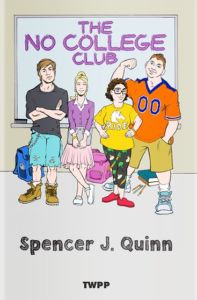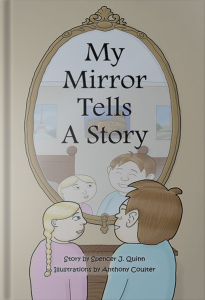Spencer J. Quinn’s The No College Club: A Review
Posted By Anthony Bavaria On In North American New Right | Comments Disabled [1]
[1]You can buy Spencer J. Quinn’s young adult novel The No College Club here [2].
1,139 words
It’s hard to be the first at anything these days, but here is Spencer J. Quinn’s The No College Club, which is billed as the first white-positive young adult (YA) novel. Based on the story’s contents, hopefully it’s the first of many in a much-needed genre.
Having been the furthest thing from “bookish” as an adolescent, I’ve never read anything else in the YA sphere, but that doesn’t prevent me from having tangentially absorbed a decent amount of the genre. Our modern era fast-tracks much youth-oriented fiction to the bookshelves and silver screens across the globe, for it acts as a near-perfect vehicle to poison the minds of future generations. Unlike the galaxy of YA material currently out there, all of which is bursting at the seams with girl bosses and cheap simulacrums of Nazis oppressing some multi-culty band of teens, the enemy and the oppression depicted in The No College Club are actually real.
The story follows four white high school students as they suddenly find themselves on the wrong end of a racism accusation. Caroline, the main protagonist and one of the most popular girls in school, seems to have the most to lose. Derek, a loner and the primary instigator of the fiasco, is the prototypical representation of a white youth who has been excommunicated by his own country: fatherless because of Jewish wars abroad, friendless because of multiculturalism at home, and isolated because he can think independently. Then there’s Brock and Rose, an always-gets-along-with-everyone high school jock and dorky hermit respectively, who are also both unprepared for what’s to come.
 [3]
[3]You can buy Spencer J. Quinn’s My Mirror Tells a Story here. [4]
Without giving away too much of the plot, the four kids embark on an intellectual crusade that involves being assigned to give a class presentation on slavery in America. The story’s unfolding, sadly, accurately reflects the real-life headlines pertaining to race in the West. The teenagers bite off more than most kids are equipped to deal with: accusations of racism, potential expulsion from school, national-level social media scorn, their parents losing jobs as a result, physical violence, and lawfare — all of which makes an entertaining read, to say the least.
Quinn sets the stage beautifully. In describing the local pride and sense of identity in the protagonists’ small town and how it’s been affected by our nation’s “greatest strength,” he writes: “But with the recent mass influx of Hispanic migrants and Asian professionals, as well as their school system’s forced integration of black students from the nearby inner city, this identity had become both an awkward memory and a guilty pleasure.” When recounting the aftermath of a “racist” argument between Derek and his black girl-boss history teacher, Dr. Nogimbe, Quinn again hits the nail on the head of low-IQ black girl logic when a minor character, Medina, berates her peers in the following passage:
Can you believe what happened, you guys?” she asked. She slammed her milkshake on the table for emphasis. “Nogimbe really came down on that redneck, didn’t she?”
Jennifer and Priya offered some colorless commentary on the events which hinted that there might be more than one side to the story. Alarmed, Medina pointed a finger at Jennifer. “Of course, Derek got what was comin’ to him! He a racist! I always knew it. I took one look at that guy, and I was like, ‘Yep, he a racist. Pro’ly got a Klan hood in his attic somewhere.’”
“How did you know that?” Jennifer challenged.
Medina pointed to her temple. “I can tell.”
“Tell what?”
“When white people be racist. Like how you’re being right now by askin’ too many questions.”
“Asking questions is not racist, Medina,” Priya objected.
“Is too,” Medina insisted.
“How can you say that?”
“I just did.”
Jennifer shook her head and pushed her lunch away from her. “That doesn’t even make sense.”
“Oh, so you’re gonna tell me that Derek Brand isn’t a racist now?”
“No, of course he is.”
“And you’re gonna tell me he has the right to talk back to Dr. Nogimbe?”
“I’m not saying that,” Jennifer insisted.
“Yeah, Medina, she’s not saying that,” Priya added.
“I’m just saying that just asking questions does not make a person racist.”
“Oh, that’s ridic’lus.”
“It’s not ridiculous, Medina,” Jennifer said. “It’s freedom of speech. Like in the Constitution.”
Medina scoffed with a snort. “Constitution! Ugh!”
“What’s wrong with the Constitution?” Priya asked.
“It was written by buncha slave-owning white supremacists!” Medina shouted back. “That’s what’s wrong with it.”
This got the attention of others in the cafeteria, and Medina toned down her tirade, but only a little. “You remember what Dr. Nogimbe said about their immigration act, don’t you? Whites only.”
“Free whites only,” Caroline corrected.
One of the book’s main themes is slavery, both black and white. In a recent podcast interview with Pox Populi [5], Quinn discussed the importance of this subject for America, as well as that of possessing a general understanding of your own people’s history. He says the novel is, in part, about “unerasing” aspects of white people’s history on the American continent. He goes into further detail on this subject in his review “Simon Webb’s The Forgotten Slave Trade [6],” as well as his article “A Reading List on White Slavery. [7]”
Though the novel is written with young adults in mind, it can easily be read by anyone — especially someone with young children of their own, since this is the world they now live in. This is a notion I initially wrestled with when beginning to read a novel geared toward teenagers with white-positivity in mind. It’s potentially risky to entice children to expose themselves to the degree the protagonists do, but, as mentioned above, this story by no means sugar-coats the consequences of doing so. What ultimately brought me around to the concept was the very basic fact that white children simply have zero positive reinforcement of their people and history in our current zeitgeist, despite the fact that this is absolutely essential for a healthy mindset.
As far as white identity politics goes, I honestly don’t think we’re going to win with reason, for our enemy is unreasonable. Being right is irrelevant in the age of subjective reality. How do you combat a secular faith-based society with mere logic? The ease with which academia, the government, and the media perform mental gymnastics to blame black-on-black/white/yellow/brown crime on “white-supremacy” should be proof enough by this point. I’m not sure if Quinn agrees with this, but it’s irrelevant in his work, for this book and the ideas expressed in it do not appear to try and convince others, but are simply for the preservation of the reader’s sanity — to remind them to love themselves and their people, and that staying true to honor, morality, and truth can keep a person whole. This is more important today than ever before for our youth.
* * *
Like all journals of dissident ideas, Counter-Currents depends on the support of readers like you. Help us compete with the censors of the Left and the violent accelerationists of the Right with a donation today. (The easiest way to help is with an e-check donation. All you need is your checkbook.)
For other ways to donate, click here [8].